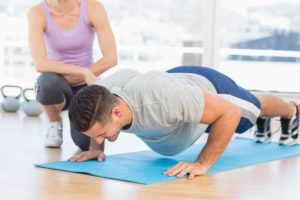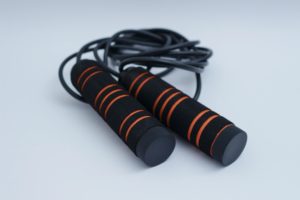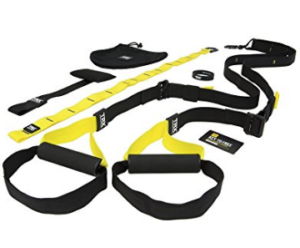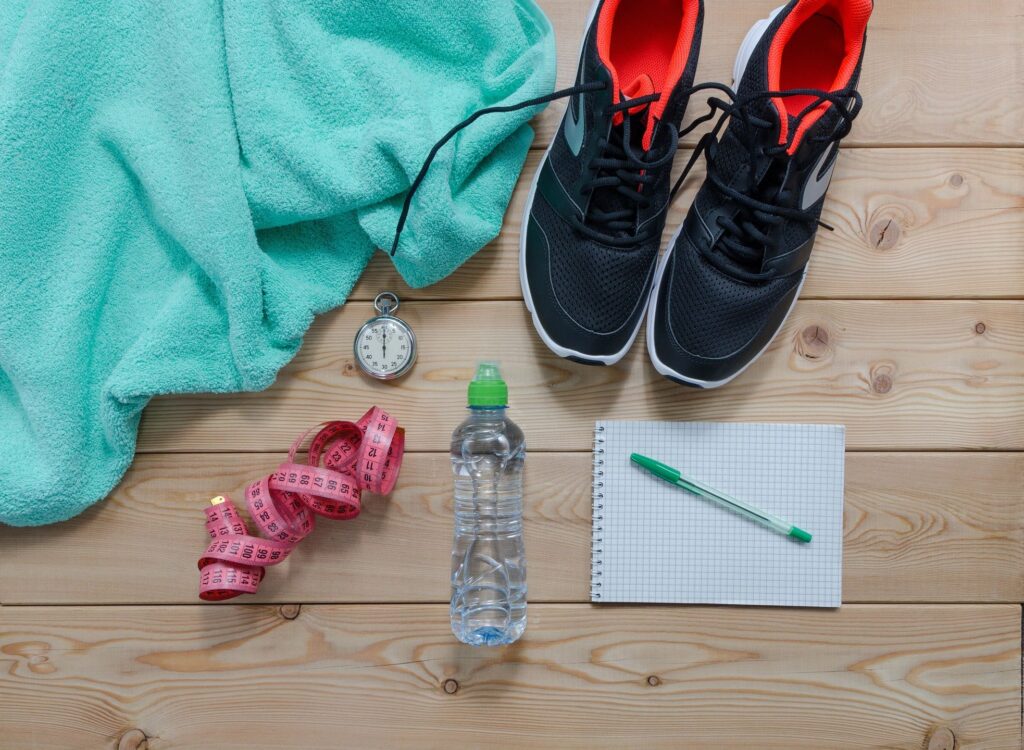If the main reason you don’t make it to the gym is that you just don’t have time to go, you’re definitely not alone.
In fact, 67% of people with gym memberships never use them, and the average person goes to the gym just twice a week. Sorry, but you’ll likely not see results from two training sessions per week. (Reference: Statistic Brain)
While nothing will replace a good strength training program (which generally requires weights and a gym membership), there are a ton of ways to get an effective workout at home with little to no investment in exercise equipment.
An ideal strength training program will have you training 3-4 times per week. If you can make it to the gym on 1-2 of those days, you can compliment your gym training with 1-2 workouts at home. Strength training workouts should take approximately 30-40 minutes. Including drive time, you’re looking at committing only one to two hours per week to hitting the gym.
Whether your goal is to lose weight, build muscle, tone up, or just not look so squishy, read on to decide the best way to set up your hybrid home/gym workout routine.
Building A Home Gym On A Budget
The first thing you must do is assess the space you’re working with. Do you have a basement, garage, or spare room to dedicate to gym space? Great! You’ll be able to fill it with fun workout toys.
On the flip side of the coin, do you only have a small corner of a room to work with? That’s okay, too, you’ll just need to get creative.
 Either way, dedicate a specific space in your home to exercising. Much like having a gym membership gives people a set space to enter “workout mode,” when you step into this specific place in your home, you’ll know it’s time to exercise.
Either way, dedicate a specific space in your home to exercising. Much like having a gym membership gives people a set space to enter “workout mode,” when you step into this specific place in your home, you’ll know it’s time to exercise.
Once you’ve set aside gym space in your home, consider buying plastic storage bins to stash your workout gear out of sight. This is especially helpful if your workout space is in a room that serves another purpose.
Home gym essentials
Don’t think that you need to purchase a recumbent bike or full weight set to get a great workout. Bodyweight exercises are fantastic for getting in shape, and if you’re a beginner, that may be all you need to get started.
 A jump rope is all the cardio equipment you need, and the price is right, as even the priciest ropes will run under $20. Personally, I think jumping rope is more fun that running anyway, and it’s a much more efficient cardio method. Try skipping rope for about thirty seconds, and you’ll see what I mean.
A jump rope is all the cardio equipment you need, and the price is right, as even the priciest ropes will run under $20. Personally, I think jumping rope is more fun that running anyway, and it’s a much more efficient cardio method. Try skipping rope for about thirty seconds, and you’ll see what I mean.
There is plenty of affordable equipment you can purchase to stock your home gym and progress your workouts. The number one piece of equipment I recommend investing in is a durable set of resistance bands. These are a great option for loading any exercise from squats and deadlifts to presses and rows.
If you have a little more wiggle room in your budget, adjustable weights are a fantastic purchase. These take up less space than a full weight set and usually adjust from 2.5-lbs up to 25-lb, depending on the brand and model.
Investing in a few kettlebells infinitely expands your workout options. You’ll want one or two heavy bells for lower body exercises like squats and swings, and one or two lighter bells for upper body exercises like presses and rows.
Dumbbells and kettlebells typically cost about $1 or more per pound, so they can be a pricier purchase, but the investment is totally worth it if you can spare the money.
Most pull up bars cost about $30 and can hang from any doorway in your exercise space. (Don’t worry if you can’t do a full pull-up; you can use a chair or resistance band for assistance.)
 If weightlifting isn’t your cup of tea, or adjustable weights and kettlebells are too expensive, a suspension trainer is a great alternative. The TRX Go! model is affordable ($100) and can be mounted to your ceiling with an included attachment or hung from a doorway. While TRX is the biggest name brand of suspension trainers, there are a lot of “off brands” available at lower price points.
If weightlifting isn’t your cup of tea, or adjustable weights and kettlebells are too expensive, a suspension trainer is a great alternative. The TRX Go! model is affordable ($100) and can be mounted to your ceiling with an included attachment or hung from a doorway. While TRX is the biggest name brand of suspension trainers, there are a lot of “off brands” available at lower price points.
Suspension trainers are wonderful for working your entire body and emphasizing your core. You can easily adjust the workout difficulty to your fitness level simply by changing where you place your feet. As a bonus, the suspension system packs up into a small carrying bag so you can bring it with you on business trips or vacations.
With so many at-home workout options, there’s no reason to feel “stuck” going to the gym every day. You can get an effective workout from training at home, but I still recommend including some gym workouts if you can find a membership to a nearby gym.
Designing Your Hybrid Home/Gym Training Program
As mentioned above, a good strength training program will require 3-4 days of resistance exercise. I recommend splitting up your workouts into 1-2 heavy strength training days at the gym, and supplementing with 1-2 bodyweight and lighter resistance training workouts at home.
Training in the gym
 Stick to heavy compound movements like squats, lunges, hip hinges, upper body pushes, and upper body pulls to maximize your gym time. Try to include one of each movement type per workout. Work in the 3-8 rep range for heavy strength work, and make sure you’re using enough weight that the last 1-2 reps are challenging, without compromising your form.
Stick to heavy compound movements like squats, lunges, hip hinges, upper body pushes, and upper body pulls to maximize your gym time. Try to include one of each movement type per workout. Work in the 3-8 rep range for heavy strength work, and make sure you’re using enough weight that the last 1-2 reps are challenging, without compromising your form.
Plan your workouts to take advantage of gym equipment you don’t have at home, like barbells or assisted pull up machines.
If you’re hitting the gym twice per week, you could try the following split. Simply add sets, reps, or weight each workout to continually challenge your body to adapt.
First day
- Barbell squat 4×5
- BB or DB shoulder press 4×6-8
- Lat pulldown or assisted pull-ups 4×6-8
- Back extensions 3×15
Second day
- Barbell deadlift 4×5
- Barbell bench press 4×5
- Goblet squats 3×12
- DB single-arm row 3×12/arm
Training at home
 Your home workouts will necessarily be more metabolic in nature. Your goal should be to move more and rest less to keep your heart rate high. This accommodates for the fact that you don’t have access to as much weight as you would at the gym. Instead of thinking in terms of sets and reps, use a circuit training approach.
Your home workouts will necessarily be more metabolic in nature. Your goal should be to move more and rest less to keep your heart rate high. This accommodates for the fact that you don’t have access to as much weight as you would at the gym. Instead of thinking in terms of sets and reps, use a circuit training approach.
You’ve got lots of options, from bodyweight to purchasing some of the equipment discussed above.
Bodyweight Exercise
Bodyweight training will be your bread and butter if you don’t have any equipment. Squats, lunges, glute bridges, for the lower body; push-ups and pull-ups (if possible) for the upper body.
Try this: set a time for 15-20 minutes. Perform the following exercises as a circuit for as many rounds and reps possible until time runs out. Move at a steady pace and try not to rest between exercises.
- 20 bodyweight squats
- 10 pike push ups (modify: plank shoulder taps)
- 20 forward lunges (modify with reverse lunges if you have knee pain)
- 10 push ups (modify by elevating your hands on a stable surface)
- 20 lateral lunges (advanced: plyo skater lunges)
- 10 walkouts to plank (advanced: reach hands out as far as you can)
- 10 prone back extensions
Simply by moving for the entire 15-20 minutes, you’ll get a great cardio and fat-burning effect.
While you can get a great full-body workout with just bodyweight resistance, it’s admittedly challenging to work your back without some sort of equipment, be it a pull up bar, bands, weights, or a suspension trainer. Adding any of these pieces of equipment to your home gym arsenal is a good investment.
Resistance Bands
You can use resistance bands to mimic any exercise you would do with weights at the gym. Bands are awesome for loading squats, lunges, and hip hinges, and opening up a wider variety of upper body movements. Just as with training in the gym, pick exercises that use full-body compound movements (squat, lunge, hinge, push, pull).
The added benefit of working out with bands is something called “accommodating resistance.” This means that as the band stretches, the exercise becomes harder because your muscles have to overcome the extra tension on the band. For instance, a banded bicep curl is easy at the bottom of the movement, when the band isn’t as taught; the exercise becomes more challenging as you curl your fist up toward your shoulders and stretch the band. This increases the “time under tension” and makes resistance bands an excellent choice for building bigger muscles.
Dumbbells and Kettlebells
As mentioned above, these will likely be the most expensive home gym option. I recommend investing in a single kettlebell that you can use for swings. The kettlebell swing involves a hip hinging pattern that most people need more of in their lives. We tend to train the muscles we see in the mirror, while neglecting our backsides. Swings will light up your posterior chain while working nearly every muscle in your body and elevating your heart rate. Triple win.
If you have the budget, a pair of lighter dumbbells or kettlebells that you can use for presses, rows, and getting your bicep pump can be a secondary purchase.
For the best, most efficient workout with whatever weights you have at home, take a circuit approach similar to bodyweight training. Simply incorporate your weights alongside bodyweight movements. For instance:
- 15 Goblet squats
- 10 Push ups
- 10 Bent row
- 20 KB swings
- 30-sec plank hold, repeat
Not knowing what equipment you have available in your home, I can’t make any specific recommendations for appropriate exercises. Just sure you’re moving and breaking a sweat for twenty minutes or so. Get creative with the equipment you have.
Suspension Trainers
The TRX might be the ultimate home gym accessory, and it packs up for travel, too. You can perform a variety of squats, lunges, rows, presses, and core exercises with a suspension trainer. Because the TRX offers an unstable surface from which to move, literally every exercise will force you to engage your core and stabilizing muscles.
When training with the TRX, I recommend using higher rep ranges. Three to five sets of 15+ reps will suffice for most exercises. Again, use a circuit training approach to increase the efficacy of your workout.
No Excuses
While nothing replaces a solid lifting session at the gym in terms of building a strong, toned body, you don’t have to hit the gym six days per week to get an effective workout. Whether it’s a bodyweight circuit, strength training with resistance bands, or jumping rope for cardio, you can add home workouts to your routine when you just can’t make it to the gym.

